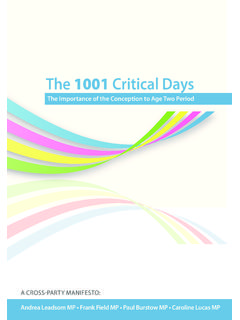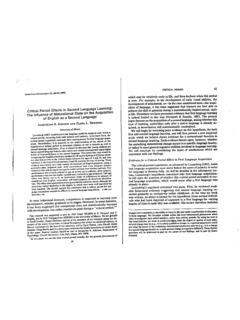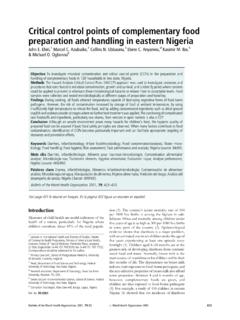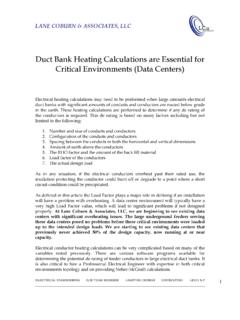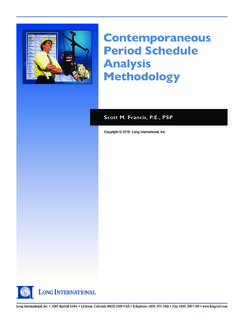Transcription of comparison of hague and hamburg-AW
1 comparison OF hague -VISBY AND hamburg RULES. Ms Anomi Wanigasekera, Attorney-at-Law, Partner, Messrs Julius & Creasy INTRODUCTION. A contract of carriage of goods by sea is between the shipper and the ship owner or carrier. The terms of the contract of carriage are generally evidenced by a document called a bill of lading. This is a receipt issued by the ship owner acknowledging that goods have been delivered to him for the purpose of carriage and the terms of the contract are incorporated in the bill of lading. This document is generally issued only after the contract of carriage is well on its way to performance. Under the common law the parties to contract of carriage of goods by sea covered by a bill of lading or similar document had complete freedom to negotiate their own terms.
2 This led the carrier to a stronger bargaining position. Ship owners/carriers went on incorporating exclusion clauses in the bills of lading, which provoked the cargo owners. Most shippers were expected either to ship on terms dictated by the carrier or not to ship at all. In England, these considerations led to the promotion of model bills of lading, which attempted to achieve a fairer balance between carriers, shippers and consignees. In other countries cargo owners were powerful enough to obtain legislation in order to adjust the balance in their favour. The first codification of law concerning the carriage of goods by sea is the Harter Act 1893 of , which was followed by the Australian Sea Carriage of Goods Act of 1904 and Canadian Carriage of Goods by Water Act of 1910.
3 These Acts influenced the formulation of the hague Rules of 1924. At the International Conference on Maritime Law held at Brussels in October 1922, the delegates at the conference, agreed unanimously to recommend their respective government to adopt as the basis of a convention a draft convention for the unification of certain rules such as responsibilities, liabilities, rights and immunities attaching to carriers under the bills of lading. In Great Britain the Draft Convention of 1923 was given statutory effect by the Carriage of Goods by Sea Act 1924. Subsequently the Draft Convention of 1923 was signed at Brussels on the 25th of August, 1924.
4 The United States adopted the hague Rules subject to some modifications, in the Carriage of Goods by Sea Act of 1936. This Act did not replace the Harter Act. In 1963 after study by the Comite Maritime International, ( )1 at Visby on the Swedish Island of Gotland adopted the text of a draft Protocol intended to make limited amendments to the 1924 Convention. This draft was considered at the 12th session of the Brussels Diplomatic Conference on Maritime Law in 1967 and 1968. The Carriage of Goods by Sea Act of 1971 was passed to give effect to the protocol. The 1971 Act was brought into force in June 1977 and it repealed the 1924.
5 Act and re-enacted the hague Rules in their amended hague Visby form. Although the 1968 Protocol made important changes, it did not radically after the compromise between the demands of the carriers on the one hand and cargo interest on the other which was embodied in the hague Rules. A report requesting for the revision of hague Rules by the secretariat of United Nations Conference on Trade and Development (UNCTAD) was published by the United Nations in 1971. The movement for reform, which began with the UNCTAD. report, culminated at the United Nations Conference on the Carriage of Goods by Sea at hamburg in 1978, with the adoption of a new convention of the Carriage of Goods by Sea the hamburg Rules.
6 The hamburg Rules became effective on 1st November, 1992. Although there are already 25 parties to the convention it has so far had no major impact on world trade. comparison OF hague RULES AND hague -VISBY RULES. The object of hague Rules and hague -Visby Rules was to protect cargo owners from widespread exclusion of liability by sea carriers. This objective was achieved by incorporating standard clauses into the bills of lading, defining the risks which must be borne by the carrier and specifying the maximum protection he could claim from exclusion and limitation of liability clauses. hague Rules and hague -Visby Rules are substantially the same except in the areas discussed below: Applicability hague Rules was restricted by the Carriage of Goods by Sea Act 1924 to bills of lading issued in respect of outward voyages from the Article X of the hague -Visby Rules has extended it to a wider ambit.
7 The wording of Art X clearly envisages an international contract of carriage between ports in different states' although Section 1 (3) of the Carriage of Goods by Sea Act 1971 extends the operation of the Rules, so far as the United Kingdom is concerned, also to cover the coastal trade. Under Section (1) (6) (B) of the 1971 1. A representative body of National Maritime Law Associations, whose main object is the unification of martitime laws. 2. Act, the rules are given the force of law in relation any receipt which is a non-negotiable document marked as such, if the contract contained in or evidenced by it is a contract of the Carriage of Goods by Sea which expressly provides that the rules are to govern that the contract as if the receipt were a bill of lading.
8 In the case of the European Enterprise2 it was held the legal effect of a clause in a negotiable receipt expressly incorporating the rule rather than any attempt to delimit the circumstances in which the Rules will be applicable to such a document. The hague Rules did not use the expression contracting State but named a country in which the law was enacted and usually provided. The bill was to contain an express statement (paramount clause) that the bill was subject to the Rules: The hague -Visby Rules used the words contracting States so that no conflict of law situations would arise. The hague -Visby Rules will apply to a contract of carriage covered by a document of title similar to the bill of lading.
9 It was seen in Kum v. Wah Tat Bank Ltd,3. how a mate's receipt by virtue of custom and trade usage could be treated as document of title. The burden of proof however is not light for the party alleging that fact. Limitation of Liability Limitation of Liability in respect of hague Rules was 100 per package coupled with the provision that it was to be gold value . [This in practice was not satisfying any objections being achieved by a limit of liability in an international convention]. The amendments to the limitation of liability are contained in Article 4 Rule 5 (a). of the schedule of the 1971 Carriage of Goods by Sea Act. Article 4 Rule 5 (a).
10 Provides 10,000 francs per package or unit or 30 francs per Problems have arisen in many countries in interpreting the term package and unit' as used in the formula. A further problem that arose in applying the hague Rules formula was to containers, pallets and other devices for the consolidation of goods and the rules limited the liability of the carrier to US$ 500/- for the entire contents of the container. In the case The Mormaclaynx 5 the cargo was described in the bill of lading as one container said to contain 99 bales of leather, it was held that each bale constituted a separate package. Conversely in the case of Standard Electrica S/A v.

